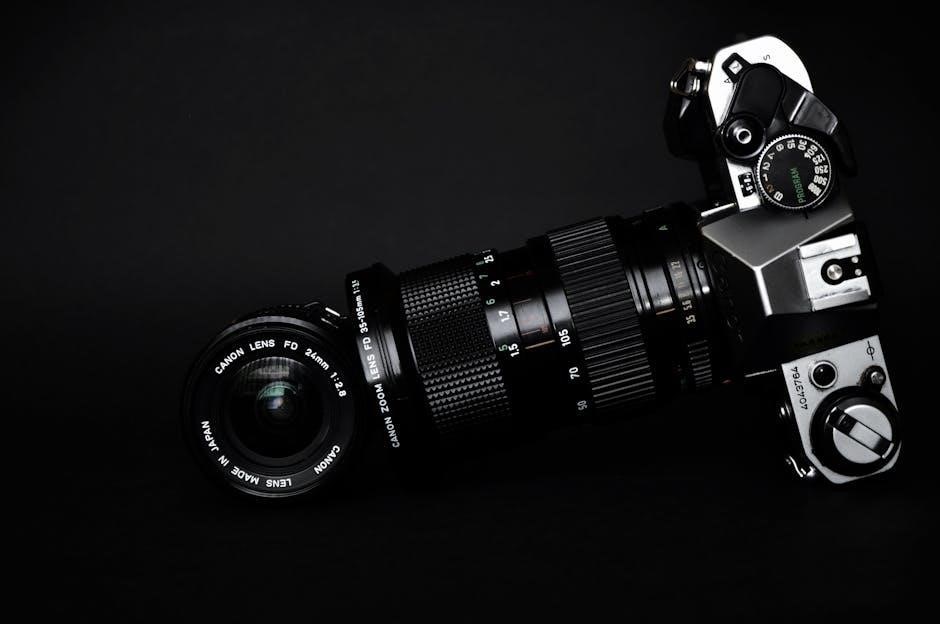Congratulations on acquiring your Tasco Trail Camera! This manual provides comprehensive guidance on setup, operation, and troubleshooting. Discover how to maximize your camera’s potential, from initial battery and SD card installation to configuring capture modes and interpreting results.
Tasco trail cameras are designed for outdoor enthusiasts, hunters, and nature observers seeking to capture wildlife activity discreetly. These cameras use motion-detection technology to automatically trigger image or video recording when an animal enters the field of view. Tasco trail cameras are built to withstand various weather conditions, ensuring reliable performance in diverse environments.
These cameras are valuable tools for scouting game, monitoring remote properties, and documenting animal behavior. With their compact size and extended battery life, Tasco trail cameras can operate unattended for extended periods. Various models offer different features, including adjustable resolution, infrared flash options, and time-lapse capabilities.
This instruction manual provides a comprehensive guide to understanding and utilizing the full potential of your Tasco trail camera. Whether you’re a seasoned outdoorsman or a beginner, this manual will assist you in setting up, operating, and maintaining your camera for optimal performance. Learn how to capture high-quality images and videos, manage power consumption, and troubleshoot common issues.
Overview of Available Manuals
Tasco offers a range of trail cameras, each with its unique features and capabilities. Consequently, a variety of instruction manuals are available to guide users through the setup, operation, and maintenance of their specific model. These manuals are essential resources for understanding the camera’s functions and maximizing its performance.
This section provides an overview of the available manuals for different Tasco trail camera models. You can typically find these manuals on the Tasco website or through authorized retailers. Manuals are often available in digital formats (PDF) for easy access and download. Some models, such as the 119270CW and 119271CW, share a common manual due to their similarities.
It’s crucial to locate the correct manual for your specific camera model to ensure you receive accurate instructions. Manuals typically cover topics such as battery installation, SD card compatibility, setting date and time, capture mode configuration, and troubleshooting common issues. Consulting the appropriate manual is the first step in resolving any problems or questions you may have regarding your Tasco trail camera.

Key Features and Specifications
This section highlights the essential features and specifications of Tasco Trail Cameras. Understanding these details will help you optimize camera settings and achieve desired results. Let’s delve into image resolution, power consumption and SD card compatibility.
Image and Video Resolution
Tasco Trail Cameras offer various image and video resolution options to suit different monitoring needs. Image resolution, measured in megapixels (MP), determines the level of detail captured in still photos. Higher megapixel counts result in larger file sizes and the ability to produce larger prints without sacrificing image quality. Depending on the specific model, Tasco Trail Cameras may offer resolutions ranging from 8MP to 12MP, or even higher.
Consider the trade-off between image quality and storage capacity when selecting the appropriate resolution. For general surveillance purposes, a lower resolution may suffice, while capturing detailed images of distant subjects may require a higher resolution setting.
Video resolution, on the other hand, determines the clarity and detail of recorded video clips. Tasco Trail Cameras typically offer video recording capabilities in resolutions such as 720p or 1080p. Higher resolution videos provide sharper images and more detail, but also consume more storage space on the SD card.
The length of video clips can also be adjusted, typically ranging from 10 seconds to longer durations. Experimenting with different video resolutions and clip lengths will help you find the optimal balance between image quality, storage capacity, and battery life for your specific application.
Power Consumption and Battery Life
Understanding the power consumption of your Tasco Trail Camera is crucial for maximizing its operational lifespan in the field. These cameras are designed for extended use in remote locations, and battery life is a key factor in their performance. Tasco Trail Cameras typically consume very little power in standby mode, often less than 0.5mA, allowing them to remain active for extended periods while waiting for trigger events.
However, power consumption increases significantly during image capture and video recording. Factors such as image resolution, video length, and the frequency of trigger events all impact battery life.
To optimize battery life, Tasco recommends using high-quality batteries, such as Energizer Lithium AA batteries, which offer superior performance in cold weather conditions and longer runtimes compared to alkaline batteries. It’s essential to avoid mixing old and new batteries or different battery types, as this can reduce overall performance and potentially damage the camera.
Rechargeable batteries are generally not recommended due to their lower voltage output and potential for inconsistent performance. Regularly checking the battery level and replacing batteries as needed will ensure your Tasco Trail Camera remains operational for extended monitoring periods.
SD Card Compatibility
The Tasco Trail Camera relies on SD (Secure Digital) memory cards for storing captured images and videos. Understanding SD card compatibility is vital for ensuring proper camera function and preventing data loss. Tasco Trail Cameras typically support standard SD and SDHC (High Capacity) cards. It is crucial to consult your specific model’s instruction manual for the maximum supported SD card capacity, as exceeding this limit can cause errors or prevent the camera from functioning correctly.
Tasco recommends using SD cards with a Class 4 rating or higher for optimal performance. Class ratings indicate the minimum data transfer speed, with higher classes ensuring smoother video recording and faster image saving.
Before using an SD card, it is recommended to format it within the Tasco Trail Camera to ensure compatibility and erase any existing data. Regular formatting can also help prevent file corruption and maintain optimal performance.
Always power off the camera before inserting or removing an SD card to avoid data loss or damage to the card or camera. It is also important to protect SD cards from extreme temperatures, moisture, and physical damage. Using a reliable SD card from a reputable brand will help ensure the longevity and reliability of your stored data.

Setup and Operation
This section details the initial setup and operation of your Tasco Trail Camera. Learn how to install batteries and SD cards, set the date and time, configure capture modes, and optimize settings for effective wildlife monitoring or security surveillance.
Battery and SD Card Installation
Proper battery and SD card installation are crucial for optimal performance of your Tasco Trail Camera. Begin by opening the camera housing, typically secured by latches on the side. Refer to your specific model’s manual for the exact location and opening mechanism. Inside, you’ll find the battery compartment and the SD card slot.
For battery installation, ensure you use the correct type and number of batteries as specified in the manual. Tasco often recommends Energizer Lithium AA batteries for extended battery life, but alkaline batteries can also be used. Pay close attention to the polarity markings (+ and -) within the compartment to insert the batteries correctly. Mixing old and new batteries or different battery types is not recommended.
Next, insert a standard SD or SDHC card into the designated slot. The camera supports various SD card capacities, usually up to 32GB, as indicated in your manual. Ensure the card is properly formatted before use. Insert the SD card with the correct orientation, typically with the label facing up. A gentle click usually indicates that the card is securely in place.
After installing the batteries and SD card, securely close the camera housing, ensuring the latches are properly fastened to maintain weather resistance. A faulty installation can cause malfunction!

Setting Date and Time
Accurately setting the date and time on your Tasco Trail Camera is essential for properly cataloging your captured images and videos. This information is typically imprinted on each file, providing a valuable reference point for identifying when events occurred. To set the date and time, you’ll need to access the camera’s setup menu.
Power on the camera and navigate to the “Setup” or “Menu” option, using the control buttons. The exact button configuration may vary slightly depending on your specific model, so consult your manual for guidance. Within the setup menu, locate the “Date/Time” setting.
Select the “Date/Time” option and use the control buttons to adjust the year, month, day, hour, and minute. The interface may present these fields sequentially, allowing you to increment or decrement each value until the correct setting is achieved. Pay close attention to the format (e.g., MM/DD/YYYY or DD/MM/YYYY) and ensure it aligns with your preference. Verify it is set to the present.
Once you’ve entered the correct date and time, save the settings. Some cameras may have a dedicated “Save” button, while others automatically store the changes. After setting this up, the camera can now be used without problems and the wrong time.
Capture Mode Configuration
The Tasco Trail Camera offers various capture modes to suit different monitoring needs. Understanding these modes and configuring them appropriately is crucial for optimizing your camera’s performance and capturing the desired footage. Typically, these modes include Photo, Video, and Hybrid (Photo + Video).
To access the capture mode settings, enter the camera’s setup menu. Navigate to the “Mode” or “Capture Mode” option. Here, you’ll find a list of available modes. Selecting “Photo” will configure the camera to capture still images when triggered by motion. You may also be able to adjust the photo resolution. Choosing “Video” will record video clips. Duration is often configurable.
The “Hybrid” or “Photo + Video” mode captures both a photo and a video clip upon each trigger. This can provide a comprehensive record of events. Once you’ve selected your desired capture mode, you may have additional settings to configure, such as the number of photos taken per trigger (in Photo mode) or the length of video clips (in Video mode).
Carefully consider the type of activity you’re monitoring and select the capture mode that best suits your needs. Experiment with different settings to find the optimal configuration for your specific environment.

Troubleshooting and FAQs
This section addresses common issues encountered while using the Tasco Trail Camera, alongside frequently asked questions to assist users in resolving problems efficiently. Before contacting customer support, review this section for potential solutions.
Q: My camera isn’t turning on. What should I do?
A: First, ensure that the batteries are new and properly installed, paying close attention to polarity. Mixing old and new batteries is not recommended. Also, verify that the power switch is in the “On” position. If the problem persists, try a different set of batteries, ensuring they are the correct type (lithium or alkaline, but not mixed).
Q: My camera is taking blank pictures. Why?
A: This can occur if the SD card is full, corrupted, or incompatible. Check the SD card’s capacity and ensure it meets the camera’s specifications. Try formatting the SD card within the camera’s settings menu (if available) or using a computer. If the issue continues, try a different SD card.
Q: How do I improve image quality?
A: Ensure the camera lens is clean. Use a soft, lint-free cloth to gently wipe away any dirt or debris. Adjust the camera’s resolution settings to the highest available. Also, consider the camera’s placement. Avoid pointing it directly at the sun, which can cause overexposure.
